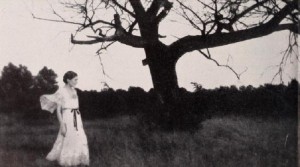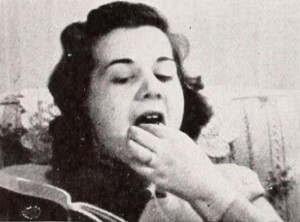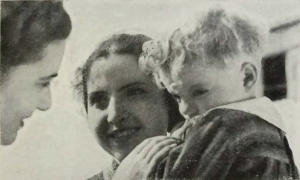A six-minute film that documents the annual procession of the Gion Festival in Kyoto on July 17, 1941. The film opens with several consecutive intertitles explaining a brief history of the festival. As he cut from one intertitle to the next, Hattori used the splicer to create the effect of a diagonal wipe, which made it appear as if the viewers were turning a page of a book.

"In his one reel film, Girl with a Dress, Clyde Hammond, ACL, has made an appealing and remarkably successful attempt to portray a drama of the spirit rather than of action. Through long weeks of bitter economy a girl accumulates enough money for a new dress. It arrives from the mail order house just in time for a summer's picnic with her friends and, happy in prospect, she wears it proudly. Then, because in it she is more charming than they, her friends will not like it, make mocking fun of her and she leaves them in tears. Stumbling home, she is caught in a shower and the dress is ruined. A simple enough tale, but in its very simplicity and sincerity lie the strength of downright tragedy. It was planned and directed with imagination and played, in its leading role, with definite and sensitive skill." Movie Makers, Dec. 1932, 562.

"In Glamour vs. Calories, C. J. Carbonaro has again turned to light comedy with a story of a wife who suspects her husband's infidelity because of her mounting avoirdupois. Excellent directorial touches are found in the scenes that would tend to corroborate her misgivings, especially in those of the gossip mongers. Many fine closeups that "plant" the suspicions contribute to the gaiety of the film, such as when the wife stoops to pick up some papers her husband has unsuspectingly dropped, only to have the seam of her dress rip from the strain. The film has interesting camera viewpoints and intelligent use of dissolves and double exposure to point up the plot. A word must be said for Mrs. Carbonaro's fine work as assistant cameraman, made necessary by the fact that her husband played one of the major roles in addition to being producer of the film, and for the high key titles with their amusing sketches. And we might add a salute to the good sportsmanship of the girl who played Mrs. Tubby, who finds a happy ending." Movie Makers, Dec. 1944, 494.
"Local newsreel events include carnival scenes at Winsford, Cheshire. Dancing troupes, decorated floats and various fancy dress characters march along the country lanes. Also features the Southport Flower Show held on August 24th,1934. Includes indoor exhibits, rock gardens and an outdoor swimming pool. Concludes with the crowning ceremony of Morecambe carnival queen. Crowds of people, sitting in rows of deckchairs, watch the event taking place." (NWFA Online Archive)
"Popular North West events from 1934 feature here. Stockport Ladies' baths reopens, with young swimmers keen to display their skills. Local people turn out for the Alderley Edge carnival parade, and huge crowds flock to see Sir Alan Cobham's Air Pageant at Woodford Aerodrome. Finally, we leave Cheshire for a trip to New Brighton, where again the crowds turn out, for fun in the new pool." (BFI Player)
"Glimpses of Rural Hungary was the first film ever made by Elizabeth Rearick but its excellence must be credited to more than beginner's luck. It represents a willingness to follow instructions carefully and an ability to compose scenes as they are selected. The picture contains a charming record of the people and customs of Hungary, but capturing this was secondary, for Miss Rearick planned the film to be principally a record of folk dances. Most unusually accurate exposure and focusing make the film outstanding in its technical aspects. Clear, crisp, steady pictures inevitably do a great deal to present a subject in a delightful way. One of the remarkable features of the film was the rock steadiness of the camera, although Miss Rearick did not use a tripod at any time. The sequencing is worked out well and, although the film is intended for use in physical education work, it has a tremendous general interest value. The entire finished product is one of which an experienced filmer might well be proud." Movie Makers, Dec. 1933, 500.

"a sogg. lungh. norm." Feature fiction film
"La grande casa, realizzato da Guido Pallaro, Cesco Cocco, Fernando de Marzi, soggetto di Giulio Fracarro, operatore Antonio Schiavinotto, interpreti Livia Lauri, Otello Toso, Lia Zanolla, Ario Chiarin, Luisa Sironi, aiuto Giorgio Pomerri. II film prodotto dalla Sezione Cinematografica del GUF di Padova che nelle prove precedenti ha dimostrato di possedere un buon numero di elementi volonterosi e di sicure possibilità, risente nel suo complesso della bontà della organizzazione; e questo un elemento da tener presente, perché mostra che ove alla buona organizzazione si venga ad aggiungere una piu persuasiva forza artistica, il gruppo Padovano potrà raggiungere risultati cospicui. Il difetto della Grande Casa sta appunto nella mancanza di forza interiore. Il tema prescelto, la costruzione della Casa dell'assistenza, non è stato svolto in uno scenario organico e provvisto di elementi atti a permettere una realizzazione più serrata e convincente; invece la narrazione è un po' preoccupata, lenta e dispersiva. Comunque il film non manca di momenti felici, di qualche buona descrizione ambientale, di sobrietà interpretativa; cosi pure l'assenza di retorica e un elemento da non trascurarsi e che torna a vantaggio della produzione."
"The Great House (La grande casa), by Guido Pallaro, Cesco Cocco, Fernando de Marzi, subject by Giulio Fracarro, cameraman Antonio Schiavinotto, actors Livia Lauri, Otello Toso, Lia Zanolla, Ario Chiarin, Luisa Sironi, assistant Giorgio Pomerri. The film produced by the Padua GUF Cinematographic Section, which in previous tests has demonstrated that it possesses a good number of willing elements and certain possibilities, suffers in its entirety from the virtue of the organization; and this is an element to keep in mind, because it shows that where good organization is added to a more persuasive artistic force, the Paduan group can achieve significant results. The defect of The Great House is precisely in its lack of inner strength. The theme chosen, the construction of the House of assistance, was not carried out in an organic scenario nor was it provisioned with elements to allow a more tight and convincing direction; instead the narrative is a little worried, slow and scattered. However, the film does not lack apt moments, of some good environmental description, of interpretative sobriety; so also the absence of rhetoric is an element not to be neglected and that returns to the advantage of the production."
—Il ventuno 28 (Review of the G.U.F. of Venice), May 1935
"Family scenes in the garden at Greenbank, Keswick - the children dance, do somersaults, skip and perform for parents and grandparents." (NWFA Online Database)
Total Pages: 29